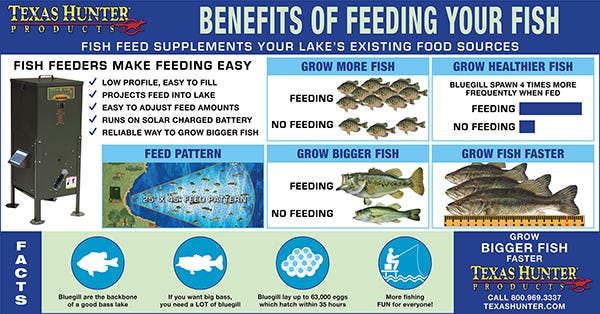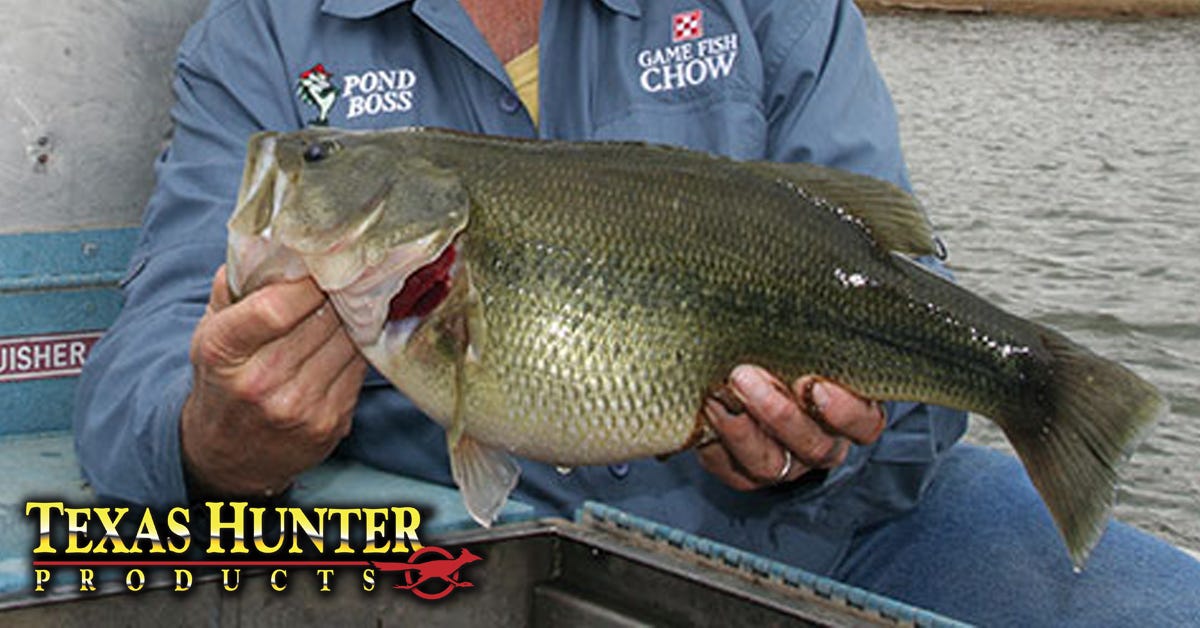- Feb 28, 2019
Growing Bigger Bass in Your Pond or Lake
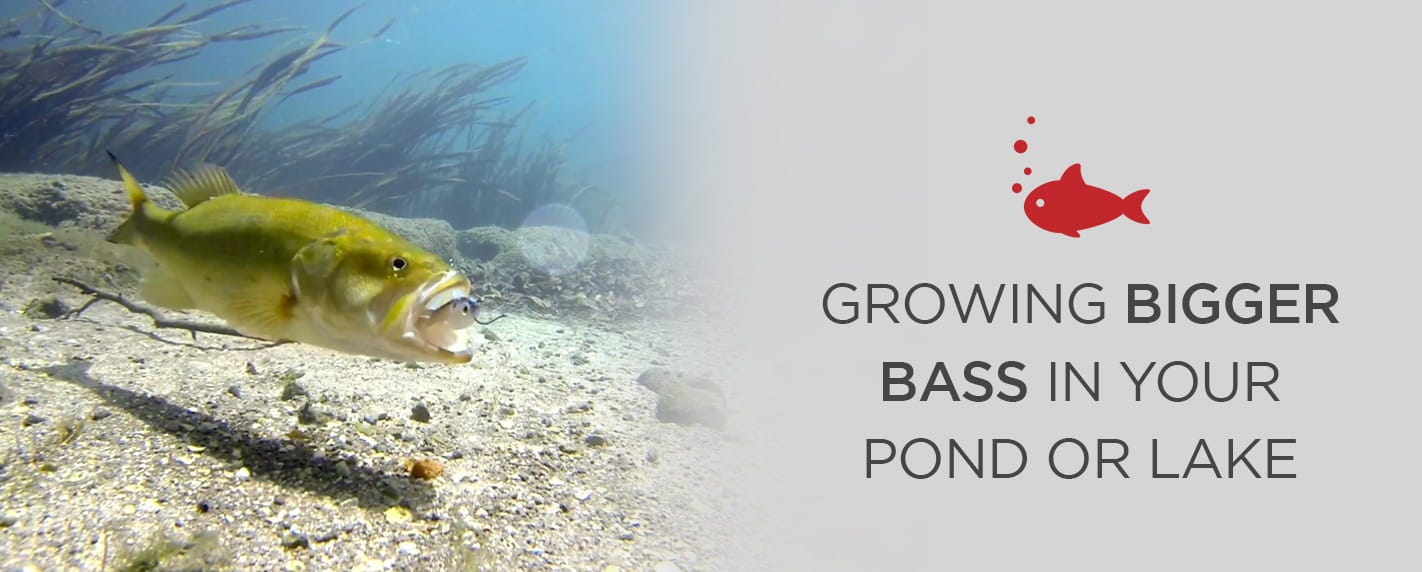
Growing Bigger Bass in Your Pond or Lake
Table of Contents
There are few fishing experiences that match catching your first largemouth bass. Or the 50th for that matter. That wonderful feeling of rising early in the morning, going out in a boat on your lake or pond or fishing from the shoreline or dock...and feeling that tug on the end of the line after you cast your lure. Or perhaps it’s a little later in the day just before dusk, and you’ve taken the grandkids out on the lake to share your joy of fishing.
Think of how great it feels and fun it is to hook a trophy bass for adults and kids alike. It’s not an impossible dream. You can grow big bass in your lake or pond, but first, you need to understand bass feeding habits and how you can develop your pond or lake’s ecosystem and food chain to support the growth of trophy bass and other sportfish.
When you learn about the important principles of pond management and then enhance those principles by adding a supplemental fish feeding program, you can grow bigger bass in a pond or lake. You also understand that growing big bass is not rocket science but good stewardship of your pond or lake environment.
Understanding Bass Feeding Habits
The first question you may ask yourself is what do bass eat? Basically, largemouth bass will eat anything that fits in their mouth. Bass are opportunistic feeders and will eat just about everything that swims in front of them, including:
- Insects
- Crayfish
- Snakes
- Smaller fish, such as shad, bluegills, crappies, herring or alewives
- Lizards
- Baby birds or ducklings
- If it’s a matter of survival, each other
One thing that bass don’t eat is vegetation. While you do need vegetation in your pond or lake’s habitat to provide places for forage and feeder fish to grow and hide, bass will not eat it.
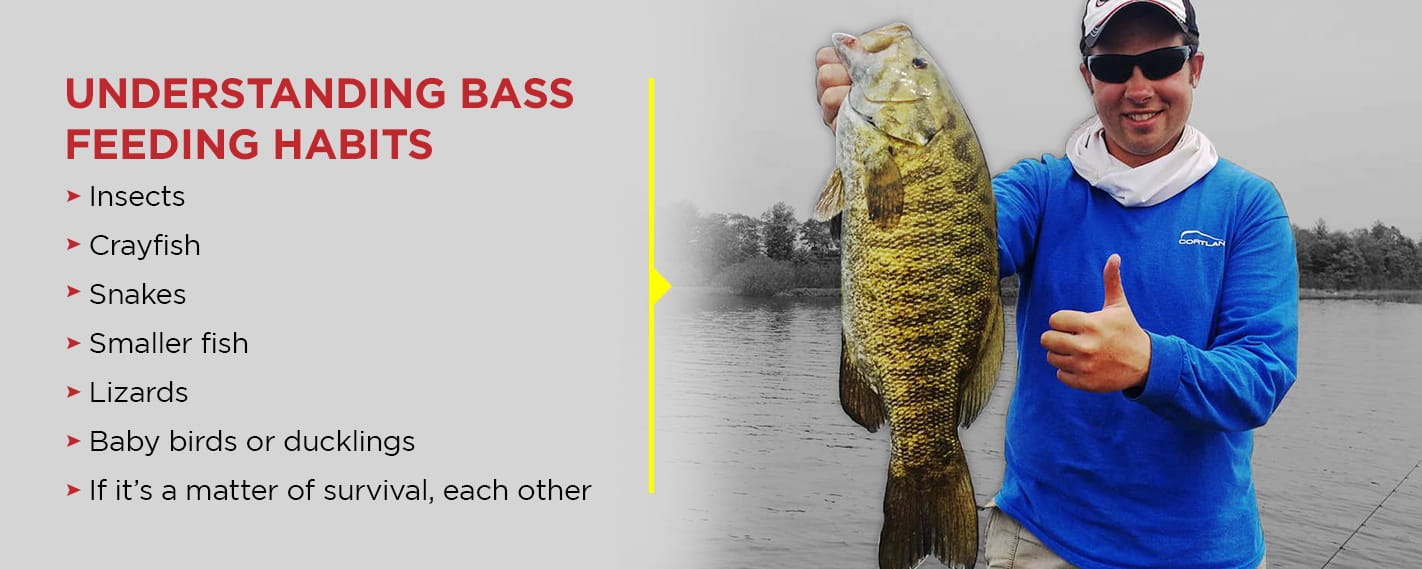
You need vegetation in your pond to help meet the goals that you want to have for a sound ecosystem. Grow pond weed around the edges of your pond or lake. Smaller fish love its density. When you take the time to learn about the kind of vegetation that you should have in your pond or lake and where to grow it, it becomes an element that helps you develop those bigger bass.
Since bass suck in their food, which often lives around vegetation, bass will occasionally inhale some plant life when eating a shad or bluegill. Bass swallow everything that’s in their mouths. They don’t gain any nutritional benefit, however, from vegetation.
What a bass eats also depends upon its size. The bigger the fish, the bigger the meal.
What do smaller bass eat? Usually, they eat smaller fish and insects. Smallmouth bass travel a pond or lake in schools. They herd smaller fish and then gang up on them. Like larger bass, they eat ravenously.
What do largemouth bass eat? Anything that swims in front of them. Their preferred meal is 5- to 7-inch forage fish like shad and bluegill. They are solitary hunters and no longer travel in schools. Largemouth bass will eat everything from a 10- to 12-inch rainbow trout to tiny grass shrimp...whatever is available and easy to catch.
When you’re thinking about the ecosystem of your pond, consider what kind of supplemental fish feeding program you want to use. You want some feed for bluegill and other forage fish. It takes 10 pounds of forage fish for a bass to grow one pound.
What Are Bass Feeding Times?
To understand bass feeding times, you need to know how their eyes work. Since bass are visual hunters, their ability to hunt depends upon how much light there is in the environment. All fish work within some range of light intensity. Some do well in blinding light, and some do well when it’s completely dark.
Bass work in between the two extremes. Their best hunting times are dawn and dusk. Bass have a large round lens that pushes its way through the pupil of the eye giving the bass has a wide field of view. But this protruding lens means that the pupil can’t open or close. It stuck open no matter how much light there is in the environment. This means that the bass has to deal with however much light there is in the environment.
What bass do have are pigment cells in the back of their eye that contain melanin. It’s the dark substance that allows humans to get a good tan. In a bass, the melanin affects how its eye works in different light conditions. So to understand a bass feeding pattern, think about how this protruding lens allows the bass to hunt at different times of the day. In the daytime, this gives the bass greater depth perception and helps them identify color more easily. When there’s less light, their eyes can take in more light so they can see better than their prey.
Thus, the best time for you to go fishing for largemouth bass are their best times to go feeding — early morning as the sun comes up and late in the day as its going down.
Understanding the Principles of Pond Management
If you want to know how to grow bigger bass in your pond or lake, you need to understand how that body of water works. Every pond or lake is unique and has its own water atributes. The five most important things to consider when it comes to pond management are:
- The quality of water
- The habitat
- The food chain
- Genetics
- Harvest
1. Quality of Water
Growing big bass means learning what you can about the properties of water. You don’t need to become a water expert, but it’s helpful to understand how its chemistry affects the biology of the water. Learn basic facts about pH, how the color of the water affects what can grow in your pond or lake and the depth of visibility. For instance, you don’t want total crystal-clear water in your pond. The best water has a slight greenish tinge to it. That is a sure sign of phytoplankton that smaller fish in your pond or lake need to eat in order to survive. Slightly bigger fish eat smaller fish, then those bigger fish become food for bass. Understanding the water in your pond goes a long way toward having a lake that produces double-digit bass.

2. Habitat
When you’re thinking about habitat, it's essential to consider the community. You want the different species of fish in your pond or your lake to live together in harmony. They need to be able to feed, congregate, ambush, spawn, hide or just be lazy and hang out.
Don’t just think of the habitat that you need for your bass. You also need to consider the habitat you need for your forage fish. Since shad and bluegill are a bass’s favorite meal, you need to find the right habitat for them. Additionally, different size fish need different habitats, so a small bass will need a different habitat than a large bass.
3. The Food Chain
As we noted above, it takes about 10 pounds of forage fish for a larger fish to gain one pound. And make sure you keep an eye on how plankton is doing in your pond as well. So it’s more important to think about providing the right kind of food for smaller fish than it is for bigger fish. When you feed smaller fish, your larger fish thrive. Fish feeders are a great way to feed the smaller fish in your pond or lake.
4. Genetics
To grow larger bass, you need to know about genetics. If you spend a lot of time and money creating the perfect pond with ideal water and a great habitat and then consider genetics as an afterthought, much of your hard effort could be wasted. Genetics play an important role in stocking and restocking your fishpond. Ideally, you want your fish to have Florida genes which many lake owners will agree, will give you the best chances of a bigger fish. If you only stock that kind of a fish in the beginning, however, but don’t think about how you’ll renew those genes, you won’t get the kind of bass you want.
Create a thoughtful genetics plan now and understand that you probably need to add new genes to your pond or lake every three or four years.
5. Harvest
At some point, your pond or lake is going to reach its maximum capacity. If you pay close attention to the first four principles, then ignore proper harvesting, you won't be able to grow the larger fish you want. Be attentive to what fish are removed and what fish are released into the pond. You should measure and weigh the bass in your pond as often as you can. If you don’t harvest enough bass, and the right kind of bass, you disrupt the food chain, and you won’t grow largemouth bass to the sizes that you wish.
Following these five principles will go a long way to giving you the best chance of growing bass that will reach double figures in weight.
Supplemental Fish Feeding Programs
The supplemental feeding of fish in your pond can keep your pond healthy, increase the sustainable populations in your pond and help your fish grow faster and larger. If your pond can naturally support a population per acre of 500 bluegill and 50 bass, you can double that per acre total with supplemental feeding. This is because when done wisely, it affects the entire food chain of a pond or lake.
Will bass eat fish food? Sometimes but not often. Largemouth bass don’t eat much fish food. Most supplemental feeding programs work with forage fish. Remember, bass like to hunt and attack their prey, so nibbling at supplemental fish food is not their first option.
Think of using your supplemental feeding program to add nutrients to the water that encourage the growth of the phytoplankton at the bottom of the food chain. While your smaller fish like bluegill and shad will feed on the insects and even smaller fish that subsist on phytoplankton, you can help your natural growth cycle by supplementing it with a fish feeding program.
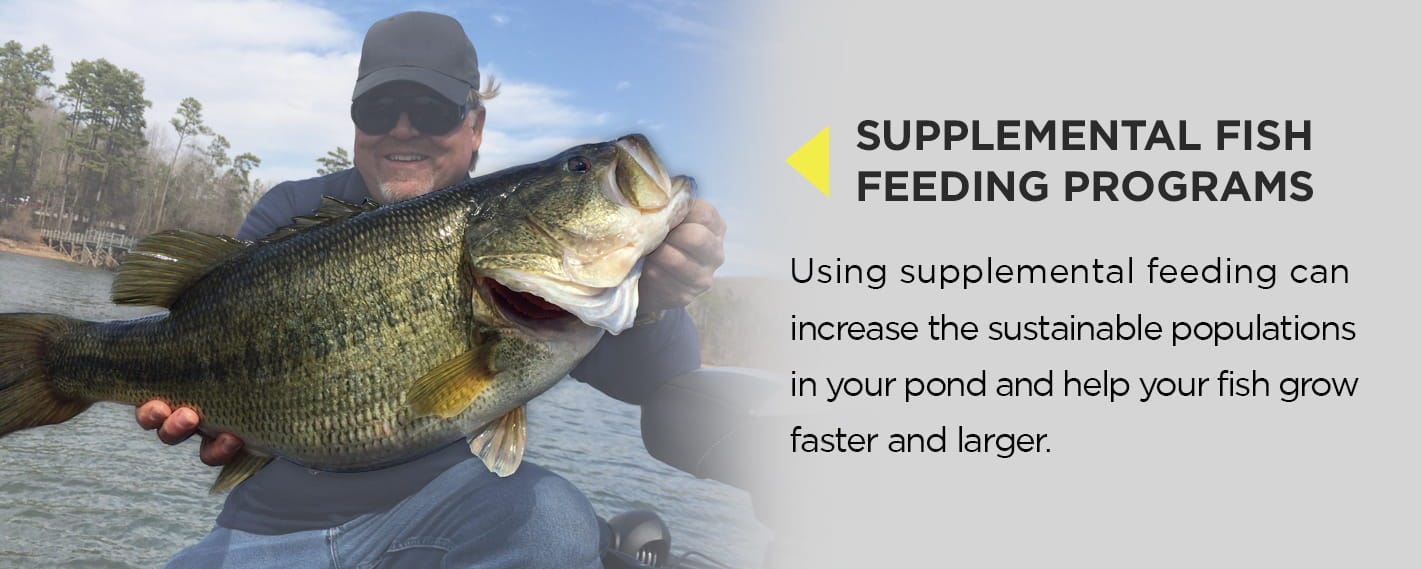
You can feed the bass in your pond by feeding the smaller bluegill and shad that the bass love to eat. Your supplemental feeding program helps to ensure the food cycle works properly.
Here are some tips about how to have a successful supplemental fish feeding program for your pond:
- When you’re stocking your pond, purchase your forage fish from vendors who have already trained the fish to eat pellets and other commercial fish feeds.
- Choose a feed that works with the size of the fish. If your fish are of different sizes, try a fish food that comes with different size particles of feed.
- Only feed your fish as much as they will eat in 10 minutes. If you see feed floating after 10 minutes, cut back the time and monitor the results.
- Start your fish feeding program when the water temperature is above 55°F.
- Establish a regular feeding routine. Feed the fish at the same time every day and in the same place.
- Be smart when picking feeding locations. Consider prevailing winds that may carry the feed across the water and other factors.
- If your pond is small, you may only need one feeding station. If your pond is 10 acres or more, then you’ll likely need multiple stations. As a rule of thumb, have one feeding station for every 5 acres of water - but consult with your lake management professional because there are other variables like fish species and total number of fish to consider.
- Train your fish to feed at regular times by using a Texas Hunter Products fish feeder.
- When you’re starting a new supplemental fish feeding program, give them a few days or a week to become accustom to the feed events you have set. As the fish become more accustomed to eating at the same time and the same place, you can come out and enjoy watching them feed. Fish Feeders also provide a area where fish tend to hang out. This is why a fish feeder is so great.
So how big do bass grow in a year? In natural environments, perhaps half a pound or more. If you follow the pond management techniques mentioned above and add a supplemental feeding program, your chances of growing larger bass are significantly improved.
Use Texas Hunter Products Fish Feeders to Grow Bigger Bass in Your Ponds and Lakes
Whether you’re interested in growing bigger largemouth bass because you've always wanted to catch a trophy fish or if you’re doing it because you enjoy the process of managing a good pond stocked with great sport fish, Texas Hunter Products has the best fish feeders to feed your fish on a regular schedule.
Texas Hunter fish feeders create a reliable food source and add much-needed nutrients to the pond to supplement the food chain to improve results for growing larger fish. Texas Hunter Products offers a variety of feeders in several capacities with shoreline, dock mounting options and hanging fish feeders, so you're sure to find a fish feeder that works best for you.
Texas Hunter Products offers shoreline mounted feeders in three sizes: 70 lb. Capacity, 175 lb. Capacity, & 250 lb. Capacity.
Our dock fish feeders come in three sizes: 70 lb. Capacity, 175 lb. Capacity, & 250 lb. Capacity. All Texas Hunter fish feeders can also take advantage of free energy from the sun with our 2-watt solar charger.

Once you have seen our wide variety of fish feeders, place an order online or call us at 800-969-3337 to order or locate an authorized dealer near you. If you have any questions, please Contact Us! With Texas Hunter Products you can have the fishing experience you’ve always wanted.


